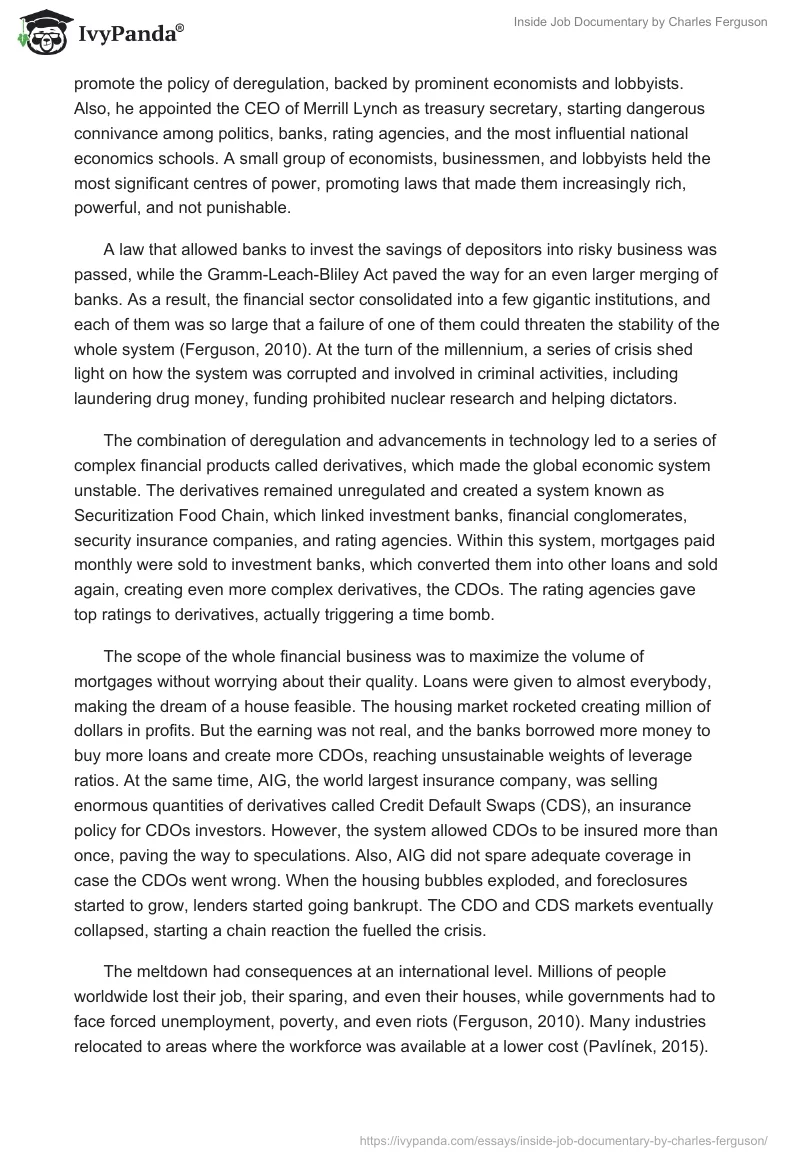Introduction
In 2008, the worst financial crisis after the Great Depression plunged the United States and the world into recession. The deregulation policies initiated during the 1980s have been indicated as the cause that led to the collapse of the economy. However, some studies argue that the deregulation hypotheses are incorrect, suggesting that the crisis was the result of a particular macroeconomic background (Shaanan, 2017). The Inside Job analyses the crisis and discloses a disturbing scenario of collisions and conflicts of interest between politics and finance.
Inside Inside Job
In September 2008, the investment bank Lehman Brothers, one of the largest investment banks worldwide, declared bankruptcy, throwing the global financial world into chaos. The meltdown cost over 20 trillion dollars, while millions of people lost their homes and jobs (Ferguson, 2010). Terms as the housing bubble, subprime mortgage, and Collateralized Debt Obligations (CDOs) became infamously well known. However, drawing a clear picture of the coeval economic world is a hard task. The 2010 documentary Inside Job, directed by Charles Ferguson, investigates events, causes, and effects of the crisis, shedding light on the ethical and moral aspects of the complex bonds between the financial industry and politics. To understand how the crisis matured it is crucial to look back to the deregulation policies of the 1980s.
After the Great Depression, the American economy witnessed forty years of constant economic growth. The financial sector was strictly regulated, and every possible speculation using the depositors’ savings was prohibited. On the other hand, investing banks were small private partnerships where the partners watched the invested money meticulously (Ferguson, 2010). During the 1980s, everything changed when the investment banks went public, and huge amounts of money became available through the investment of the stakeholders. In 1981, President Reagan began to promote the policy of deregulation, backed by prominent economists and lobbyists. Also, he appointed the CEO of Merrill Lynch as treasury secretary, starting dangerous connivance among politics, banks, rating agencies, and the most influential national economics schools. A small group of economists, businessmen, and lobbyists held the most significant centres of power, promoting laws that made them increasingly rich, powerful, and not punishable.
A law that allowed banks to invest the savings of depositors into risky business was passed, while the Gramm-Leach-Bliley Act paved the way for an even larger merging of banks. As a result, the financial sector consolidated into a few gigantic institutions, and each of them was so large that a failure of one of them could threaten the stability of the whole system (Ferguson, 2010). At the turn of the millennium, a series of crisis shed light on how the system was corrupted and involved in criminal activities, including laundering drug money, funding prohibited nuclear research and helping dictators.
The combination of deregulation and advancements in technology led to a series of complex financial products called derivatives, which made the global economic system unstable. The derivatives remained unregulated and created a system known as Securitization Food Chain, which linked investment banks, financial conglomerates, security insurance companies, and rating agencies. Within this system, mortgages paid monthly were sold to investment banks, which converted them into other loans and sold again, creating even more complex derivatives, the CDOs. The rating agencies gave top ratings to derivatives, actually triggering a time bomb.
The scope of the whole financial business was to maximize the volume of mortgages without worrying about their quality. Loans were given to almost everybody, making the dream of a house feasible. The housing market rocketed creating million of dollars in profits. But the earning was not real, and the banks borrowed more money to buy more loans and create more CDOs, reaching unsustainable weights of leverage ratios. At the same time, AIG, the world largest insurance company, was selling enormous quantities of derivatives called Credit Default Swaps (CDS), an insurance policy for CDOs investors. However, the system allowed CDOs to be insured more than once, paving the way to speculations. Also, AIG did not spare adequate coverage in case the CDOs went wrong. When the housing bubbles exploded, and foreclosures started to grow, lenders started going bankrupt. The CDO and CDS markets eventually collapsed, starting a chain reaction the fuelled the crisis.
The meltdown had consequences at an international level. Millions of people worldwide lost their job, their sparing, and even their houses, while governments had to face forced unemployment, poverty, and even riots (Ferguson, 2010). Many industries relocated to areas where the workforce was available at a lower cost (Pavlínek, 2015). The economic growth experienced a sudden stop even in emerging countries as China and Singapore.
Conclusion
The deregulation policies of the 1980s and the rise of an elite able to control politics and economics led to the birth of a few financial giants, huge profits, and instability of the market. The housing bubble triggered the collapse of the system, causing a global crisis. The Inside Job uncovers the perverse relations between economic and political power, highlighting how the responsible for the crisis went unpunished, despite their greed had caused damages to millions of people worldwide.
References
Ferguson, C. (2010). Inside job [Motion picture]. Sony Pictures Classics.
Pavlínek, P. (2015). The impact of the 2008–2009 crisis on the automotive industry: Global trends and firm-level effects in Central Europe. European Urban and Regional Studies, 22(1), 20-40. Web.
Shaanan, J. (2017). America’s free market myths: Debunking market fundamentalism. Cham, Switzerland: Springer.


